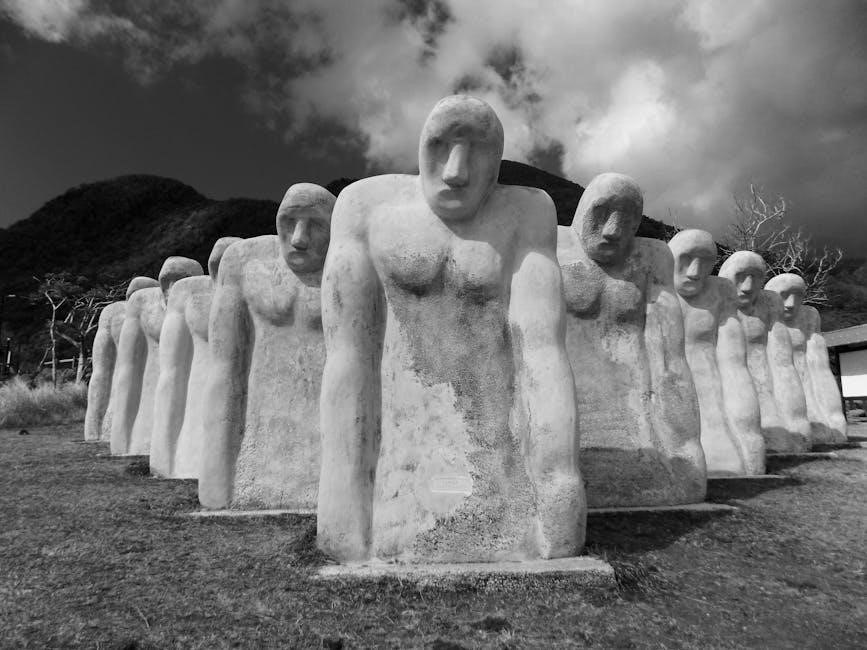Melton A. McLaurin’s Celia, a Slave recounts the harrowing true story of a young enslaved woman’s struggle against exploitation and injustice in 19th-century America, exploring themes of morality, gender, and power.
Overview of the Book
Celia, a Slave by Melton A. McLaurin is a gripping historical account of a young enslaved woman’s life, exploitation, and tragic fate in antebellum Missouri. The book delves into the moral complexities of slavery, focusing on Celia’s resilience and the legal battles surrounding her case. McLaurin examines the power dynamics between enslaved individuals and their enslavers, shedding light on the sexual exploitation of enslaved women and the societal norms that enabled such abuse. This powerful narrative not only highlights Celia’s story but also critiques the legal and ethical failures of a slaveholding society. Available as a PDF, it remains a vital resource for understanding this dark chapter of American history.
Historical Context of Slavery in the United States
Slavery in 19th-century America, particularly in Missouri, was deeply entrenched, with enslaved individuals treated as property rather than humans. The legal system perpetuated racial disparities, denying slaves basic rights and protections. Celia’s story reflects the brutal realities of this era, highlighting the exploitation and abuse endured by enslaved individuals, especially women. McLaurin’s work underscores the societal norms that enabled such injustices and the moral failings of a system that dehumanized people of color. This context is crucial for understanding Celia’s case and its broader implications for race, gender, and justice in America during this period.
The Life of Celia
Celia, a young enslaved woman in 1850s Missouri, endured a life marked by hardship, abuse, and resilience, ultimately facing tragic circumstances that led to her execution in 1855.
Early Life and Enslavement
Celia’s early life remains shrouded in obscurity, typical of enslaved individuals. Born into slavery, her childhood was marked by hardship and displacement. At fourteen, she was acquired by Robert Newsom, a Missouri farmer, initiating a period of forced labor and exploitation. Her enslavement stripped her of autonomy, subjecting her to the harsh realities of slavery. Despite the lack of detailed records, her story reflects the broader experiences of enslaved women, highlighting the dehumanizing conditions they endured.
Celia’s Acquisition by Robert Newsom
In 1850, 14-year-old Celia was purchased by Robert Newsom, a prosperous Missouri farmer. Her acquisition marked the beginning of a life of forced labor and exploitation. Newsom, a respected figure in his community, subjected Celia to both physical and sexual abuse, exploiting the power dynamics inherent in slavery. Her enslavement under Newsom highlighted the brutal realities of the institution, where enslaved individuals were treated as property rather than human beings. This acquisition set the stage for the tragic events that would unfold in her life.
Conditions of Slavery in Missouri
Conditions of Slavery in Missouri
In 1850s Missouri, slavery was deeply entrenched, with enslaved individuals subjected to harsh labor and brutal treatment. The state’s economy relied heavily on agriculture, particularly tobacco and hemp, which intensified the exploitation of enslaved people. Enslaved women like Celia faced additional vulnerabilities, as Missouri law permitted the rape of slaves, denying them legal protection. Societal norms further perpetuated their suffering, as white women often remained silent or complicit in such abuses. These conditions underscored the dehumanizing nature of slavery and the powerlessness of enslaved individuals in antebellum Missouri.
The Crime and Trial
Celia’s murder of Robert Newsom and subsequent trial exposed the legal and moral failings of a slaveholding society, sparking debates on justice and human rights.
The Murder of Robert Newsom
Celia, a young enslaved woman, killed her abusive enslaver, Robert Newsom, in 1855 after years of sexual exploitation. The act, a desperate response to relentless abuse, shocked the community. Newsom’s death highlighted the brutal realities of slavery and the moral complexities faced by enslaved individuals. Celia’s actions were both an act of resistance and a tragic consequence of systemic oppression. The event became a focal point for legal and societal debates, underscoring the inhumane conditions endured by enslaved people and the ethical dilemmas embedded in the institution of slavery.
Celia’s Confession and Legal Proceedings
Celia confessed to killing Robert Newsom, her enslaver, after enduring years of sexual abuse. Her legal proceedings revealed the harsh realities of slavery’s legal framework, where enslaved individuals were treated as property rather than people. Despite her testimony of prolonged exploitation, Missouri law at the time did not recognize rape of a slave as a crime. The court focused on the murder charge, and Celia’s defense of self-protection was dismissed. Her appeals were denied, and she was ultimately sentenced to death, reflecting the systemic injustice faced by enslaved women in antebellum America.
Key Arguments in the Trial
Celia’s defense argued she acted in self-defense against Robert Newsom’s prolonged sexual abuse, while the prosecution emphasized the legality of killing a master. Her lawyers contended that Newsom’s actions constituted assault, justifying her response. However, Missouri law at the time did not recognize rape of a slave as a crime, undermining her case. The prosecution maintained that a slave had no legal right to resist their master, even in cases of abuse. These arguments highlighted the stark inequality and legal vulnerabilities faced by enslaved individuals, ultimately leading to her conviction and execution.

Sexual Exploitation and Power Dynamics
Celia’s story exposes the systemic sexual exploitation of enslaved women and the power imbalance that enabled such abuse, reflecting broader societal norms of the antebellum South.
Sexual Abuse of Enslaved Women
Enslaved women like Celia faced pervasive sexual exploitation, as their bodies were subjected to the whims of their enslavers. The institution of slavery normalized such violence, with enslaved women often being stripped of legal protections. Celia’s story starkly illustrates how enslaved women were preyed upon, their autonomy denied, and their humanity ignored. The societal acceptance of these practices underscored the dehumanizing nature of slavery, where enslaved women were treated as property rather than individuals. This systemic abuse was deeply intertwined with the power dynamics of the antebellum South, where white men held unchecked authority over enslaved people.
Robert Newsom’s Abuse of Celia
Robert Newsom’s ownership of Celia was marked by relentless sexual exploitation, which began when she was just fourteen. Newsom’s actions exemplified the broader pattern of abuse faced by enslaved women, where their enslavers wielded absolute power. Celia’s resistance to this abuse ultimately led to tragic consequences, as she fought against the systemic violence perpetuated by Newsom. His exploitation of Celia highlighted the inherent brutality of slavery, where enslaved individuals were denied their basic rights and subjected to unimaginable suffering. This abuse was not only physical but also deeply psychological, leaving lasting scars on Celia’s life.
Social Norms and Silence Around Abuse
Societal norms in antebellum America perpetuated silence around the abuse of enslaved women, as slavery normalized exploitation. White women often remained complicit, bound by their dependence on the slaveholding system. Their silence enabled the unchecked power of enslavers like Robert Newsom, who abused Celia without fear of accountability. The broader culture of racism and patriarchy suppressed any acknowledgment of enslaved women’s suffering, ensuring their voices remained unheard. This collective silence reinforced the brutal realities of slavery, allowing such abuses to persist unchallenged. The societal structures of the time effectively erased the humanity of enslaved individuals, perpetuating injustice.
Legal and Moral Issues
The legal system upheld the enslavement of individuals like Celia, while societal norms ignored the moral atrocities of slavery, highlighting the deep ethical contradictions of the era.
Legal Status of Slaves in Missouri
In 1850s Missouri, enslaved individuals like Celia were legally classified as property, devoid of basic human rights or legal personhood. The state’s laws denied slaves the right to testify against white individuals or seek legal recourse for abuses. This systemic dehumanization perpetuated exploitation, as enslaved women were particularly vulnerable to sexual violence, which was not recognized as a crime under Missouri law. The legal framework entrenched slavery’s brutality, leaving enslaved people defenseless and subjected to the whims of their enslavers. This context underscores the powerlessness Celia faced within the legal system.
Rape Laws and Slavery
Under Missouri law in the 1850s, enslaved individuals were not recognized as legal persons, and rape of a slave was not considered a crime. This legal framework perpetuated the sexual exploitation of enslaved women, as their bodies were treated as property rather than their own. The law effectively silenced enslaved women, denying them any legal recourse against their oppressors. This systemic dehumanization was central to the institution of slavery, enabling masters to exploit enslaved individuals without fear of legal consequences.
Celia’s case starkly illustrates how these laws failed to protect enslaved women, leaving them vulnerable to unchecked abuse. The legal system’s complicity in slavery’s brutality underscores the moral failings of a society that condoned such exploitation.
Moral Dilemmas in Slaveholding Society
The story of Celia exposes the profound moral contradictions within a society that normalized slavery. Enslaved individuals were denied basic human rights, and their exploitation was justified through legal and social frameworks. The sexual abuse of enslaved women like Celia highlights the immorality of a system that treated people as property rather than human beings. Despite the horrors of slavery, many in society turned a blind eye, complicit in upholding an institution that violated fundamental ethical principles. McLaurin’s account challenges readers to confront the moral failings of a slaveholding society and the silence that perpetuated its injustices.

Gender Roles in Antebellum Society
Enslaved women like Celia faced dual oppression, forced into labor and subjected to sexual exploitation, while white women were expected to uphold patriarchal norms and silence.
Role of Enslaved Women
Enslaved women like Celia were subjected to a dual burden of labor and sexual exploitation, denied basic rights and autonomy. Their bodies were exploited for both reproductive and economic purposes, perpetuating the cycle of oppression. Societal norms trapped them in a system where resistance was met with harsh punishment. Celia’s story highlights the brutal realities of enslaved women’s lives, forced to endure unimaginable suffering while being stripped of their humanity. Her case underscores the pervasive gendered violence and the lack of legal protections for enslaved women in antebellum America, revealing the deep moral failings of the slaveholding society.
White Women’s Complicity and Silence
White women in antebellum society often turned a blind eye to the sexual exploitation of enslaved women, maintaining silence that perpetuated the oppression. Their complicity stemmed from societal roles that emphasized maintaining domestic order and upholding their husbands’ authority. Despite awareness of abuses, many chose not to intervene, fearing disruption of their households or societal standing. Celia’s case illustrates how white women’s silence enabled slaveholders’ power, highlighting the complex web of gender and race that sustained slavery. Their inaction contributed to the systemic dehumanization of enslaved women, underscoring the moral complexities of the time.
Male Dominance and Power Structures
Male dominance in antebellum society was deeply entrenched, with white men holding absolute authority over both enslaved individuals and white women. This power structure allowed slaveholders like Robert Newsom to exploit enslaved women sexually with impunity. The legal system reinforced this dominance, denying enslaved individuals legal recourse against their oppressors. Celia’s case starkly exposes how male power perpetuated systemic oppression, creating a culture where violence against enslaved women was normalized and protected. This hierarchy of power underscored the pervasive inequality of the time, shaping the tragic events of Celia’s life and trial. The entrenched societal norms ensured that male dominance remained unchallenged.

The Execution and Legacy
Celia was executed in 1855 for murdering her enslaver, Robert Newsom, after years of sexual exploitation. Her story has endured, raising awareness of slavery’s brutal realities and inspiring modern reflections on justice and human rights.
Celia’s Execution in 1855
Celia, a 19-year-old enslaved woman, was executed by hanging on December 21, 1855, in Fulton, Missouri, for the murder of her enslaver, Robert Newsom. Her death marked the tragic end of a life defined by exploitation and resilience. Despite her confession and the legal proceedings that highlighted the abuse she endured, Celia was denied justice under a system that dehumanized enslaved individuals. Her execution remains a poignant symbol of the brutal realities of slavery, particularly the sexual violence endured by enslaved women. Celia’s story continues to resonate as a powerful reminder of the moral failures of a slaveholding society.
Impact of Celia’s Story on Society
Celia’s story has had a profound impact on societal understanding of slavery’s brutality, particularly the exploitation of enslaved women. Her case exposed the systemic injustices and moral failings of a society that condoned sexual violence against enslaved individuals. Melton A. McLaurin’s book has played a crucial role in raising awareness, sparking discussions about race, gender, and power. Celia’s legacy continues to inspire reflection on the historical and ongoing struggles for justice and equality, resonating deeply in modern conversations about racial disparities and human rights, ensuring her story remains a vital part of historical memory.
Modern Relevance of Celia’s Case
Celia’s story remains deeply relevant today, offering a poignant reminder of systemic racism, gender inequality, and the exploitation of marginalized groups. Her case highlights the long-lasting impacts of slavery and its legacy in modern society. The book serves as a powerful tool for understanding the intersectionality of race and gender, resonating with contemporary discussions about justice, equality, and human rights. Celia’s fight for dignity and survival continues to inspire conversations about systemic oppression and the ongoing struggle for racial and gender justice, making her story a critical part of modern social and historical discourse.

Literary and Historical Significance
Melton A. McLaurin’s Celia, a Slave is a powerful historical account illuminating the moral dilemmas of slavery. It remains a significant literary masterpiece, offering profound insights into America’s past.
Melton A. McLaurin’s Contribution
Melton A. McLaurin’s Celia, a Slave is a groundbreaking work that sheds light on the atrocities of slavery and gender exploitation. Through meticulous research and compelling storytelling, McLaurin humanizes Celia, offering a poignant exploration of her life, struggles, and ultimate tragedy. His work not only challenges the historical narrative but also provides a platform for voices silenced by oppression. McLaurin’s contribution lies in his ability to weave historical facts with emotional depth, making Celia’s story a testament to resilience and a critique of systemic injustice, ensuring her legacy endures for future generations to reflect upon.
Reception of the Book
Celia, a Slave has garnered critical acclaim for its powerful narrative and historical depth. Scholars and readers alike praise McLaurin’s meticulous research and ability to humanize Celia’s story. The book is celebrated for its unflinching portrayal of slavery’s horrors and its exploration of gender dynamics. It has been recognized as a significant contribution to historical scholarship, offering fresh insights into the experiences of enslaved women. The book’s impact extends beyond academia, sparking important discussions about race, power, and justice. Its literary merit and historical accuracy make it a vital resource for understanding America’s past.
Historical Accuracy and Scholarship
Melton A. McLaurin’s Celia, a Slave is renowned for its meticulous historical research and scholarly precision. Drawing from court records, McLaurin reconstructs Celia’s life with authenticity, offering a gripping narrative that aligns with historical evidence. The book is praised for its balanced approach, blending legal and social history to provide a comprehensive understanding of slavery’s complexities. McLaurin’s use of primary sources ensures the narrative remains grounded in fact, making it a reliable and insightful historical account. His scholarship has set a high standard for studies on slavery and gender in antebellum America.
Themes and Reflections
Celia, a Slave explores themes of power dynamics, sexual exploitation, and moral dilemmas, offering profound reflections on the societal structures that enabled slavery and its injustices.
Power Dynamics in Slavery
The institution of slavery was deeply rooted in unequal power structures, where enslaved individuals like Celia were subjected to the absolute authority of their masters. Robert Newsom exerted control over every aspect of Celia’s life, emphasizing the exploitative nature of slavery. Legal frameworks reinforced this imbalance, denying enslaved people rights or protections, even in cases of abuse. Celia’s story highlights how enslaved women were particularly vulnerable to sexual exploitation, as their bodies were treated as commodities within a system that normalized such violence. This dynamic underscores the inherent cruelty and injustice of slavery, where power was wielded without accountability.
Justice and Injustice in the Legal System
Celia’s trial exposed the entrenched racial and gender biases of the antebellum legal system, which denied enslaved individuals basic rights and protections. Despite her confession and the circumstances of abuse, the court upheld the institution of slavery, rendering her execution inevitable. The trial highlighted the legal framework that normalized violence against enslaved people while criminalizing their acts of self-defense. This case underscores the profound injustice faced by enslaved individuals, where the law served to perpetuate oppression rather than provide justice, reflecting the broader moral failings of a slaveholding society.
Moral Decisions in a Slaveholding Society
Celia’s story forces a confrontation with the moral complexities of a society rooted in slavery. Her case revealed the ethical dilemmas faced by both enslavers and the broader community, as the legality of her master’s abuse clashed with the immorality of the act. The societal norms that allowed such exploitation remained unchallenged, while Celia’s resistance highlighted the moral failings of a system that denied enslaved individuals their humanity. Her actions compelled whites to grapple with the moral implications of slavery, yet the pervasive silence and complicity of many perpetuated the status quo, underscoring the deeply ingrained hypocrisy of the time.

Download and Access Options
Celia, a Slave is available in PDF and other formats through online platforms, including academic databases and subscription services, ensuring easy access for readers and researchers globally.
PDF Downloads and Availability
Celia, a Slave is accessible in PDF format through various online platforms, including academic databases and subscription services. Users can download the book from the Internet Archive or purchase it through the University of Georgia Press website. Some platforms require a subscription or membership for faster downloads, while others offer free access to the PDF. Ethical downloading is encouraged to support the preservation of historical literature. Additionally, the book can be read online through platforms like Perlego, providing convenient access to its powerful narrative and historical insights.
Online Reading and Subscription Services
Celia, a Slave is available for online reading through platforms like Scribd, Internet Archive, and Perlego. Subscription services such as JSTOR and EBSCOhost also provide access to the book. Users can read the PDF directly in their browsers without downloading, offering a convenient option for research or personal reading; Many platforms require a membership or fee, but some, like the Internet Archive, offer free access. This makes the book accessible to a wide audience while supporting the preservation of historical literature. Online reading options ensure that Celia’s story remains readily available for educational and personal enrichment.
Academic and Educational Use
Celia, a Slave is widely used in academic settings to explore themes of slavery, gender, and justice. The book is often included in syllabi for courses on American history, African American studies, and women’s studies. Its detailed narrative and historical accuracy make it a valuable resource for scholars and students. Many universities and libraries provide access to the book in PDF format through academic databases like JSTOR and ProQuest. Additionally, the book is frequently cited in scholarly works and serves as a primary source for research on enslaved women’s experiences in the antebellum South.
Celia’s story underscores the brutal realities of slavery and the enduring fight for justice, leaving a lasting impact on historical understanding and moral reflection.
Final Thoughts on Celia’s Story
Celia’s tragic life reveals the horrors of slavery, emphasizing themes of resistance and resilience. Her story challenges societal structures that enabled exploitation and silence around abuse, leaving a profound legacy. By examining her experiences, we gain insight into the moral complexities of slavery and the enduring struggle for justice. Celia’s courage in the face of oppression serves as a reminder of the human cost of systemic injustice and the importance of remembering history to foster a more equitable future; Her case continues to resonate, urging reflection on power dynamics and human dignity.
Importance of Remembering History
Remembering Celia’s story is crucial for understanding the profound impact of slavery on individuals and society. It highlights the enduring legacy of racial inequality and the moral failings of a slaveholding society. By reflecting on her experiences, we honor her memory and confront the historical roots of contemporary injustices. Celia’s case serves as a poignant reminder of the need for empathy, education, and advocacy in addressing systemic oppression. Her story underscores the importance of preserving history to inform a more just and equitable future, ensuring that such atrocities are not forgotten or repeated.
Call to Action for Further Reading
Engage with Celia, a Slave to deepen your understanding of America’s complex history. Download the PDF or access the book through online platforms for a detailed exploration of her story. This powerful narrative sheds light on the moral dilemmas of slavery and its lasting impact. Reading Celia’s story fosters empathy and encourages reflection on the continued fight for justice and equality. Ensure her legacy endures by sharing her story and supporting educational efforts to preserve such critical historical accounts for future generations.